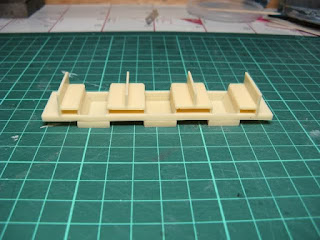It may sound like a firm of solicitors caught up in a Sherlock Holmes tale, but the purpose of these scribblings is to give an idea of the dilemma I'm currently having as to what outline my embryonic 'Atlantic' will take in the future. Given that I will probably only have one shot at building an Atlantic (donor chassis are not easy to come by at my near-Yorkshire kind of price), I want to ensure that the final choice is one that I'm happy with.
So what are the options? Ruling out the earlier Bassett-Lowke class 10 and 20 'Little Giants' on size (I've already blown the class 30 drawings up to 7.5mm scale), there are three key options to consider in outline:
1) Bassett-Lowke Class 30 outline, - 'Synolda' or 'Count Louis'...
 |
| 'Synolda' on a visit to the Kirklees Light Railway |
 |
| 'Count Louis' at the Evesham Vale Light Railway |
The classic Greenly design of these locos is a big plus point for me, however there are many differences between the survivors (and indeed the lost machine 'Sans Pariel' had a flatter cab roof), note the different drop in the rear footplate for example, whilst 'Count Louis' retains it's later cab, possibly built by Trevor Guest. The greatest temptation is perhaps 'Count Louis' with the larger Fairbourne tender, not one for the purist but at least a Kato bogie chassis can be secreted away in there.
2) Clayton/Cannon Iron Foundries/Hunt outline - 'Sutton Belle' or 'Sutton Flyer'...
 |
| 'Belle' and 'Flyer' with authentic stock at Cleethorpes |
The two Atlantics that I am most familiar with, 'Belle' is very much an "improved class 30", constructed by Douglas Clayton (and indeed originally named after him) from Bassett-Lowke castings, whilst 'Flyer' is a later, further refined design completed by Hunt's for the Sutton Miniature Railway. They may superficially look the same, but as with the surviving class 30s, there are many differences. Tender drive would be a Kato 4w unit disguised as a 6w tender. My biggest problem here is which one to choose - and how to explain to people that I won't necessarily be building the other one!
3) Barnes 'Albion' outline - 'Joan', 'John' etc
 |
| 'John' at the Evesham Vale Light Railway |
I'll be honest, in the past I've always looked on the Greenly designed, Albert Barnes built Atlantics as inferior to the class 30s. I am of course wrong, perhaps my view was tainted by the pictures of the Rhyl line in the 80s in a rather run down state. However, as the picture above shows, they can scrub up rather well, also evidenced by the recent restoration of 'Michael' at Rhyl. I'd need to drop the ex-V2 Cartazzi truck at the rear and find a suitable wheelset, but these rugged machines have an advantage over the others in that the driving wheels are spaced slight further apart. Tender drive would be as above, the disadvantage here is a slightly more open tender frame, less easy to hide that Kato unit!
4) The outsider - the 'freelance' approach...
It isn't inconceivable that a miniature railway operator could have built a loco themselves, perhaps like Douglas Clayton they bought the castings and drawings from Bassett-Lowke and slowly built it over a period of time? We have no idea how many other sets of 15" Atlantic castings Bassett-Lowke sold that were never built, there may have been many, or simply none. Or perhaps a complete new build?
 |
| Austin Moss' Atlantic project at Windmill Farm |
In the world of miniature railways, almost anything is possible!












